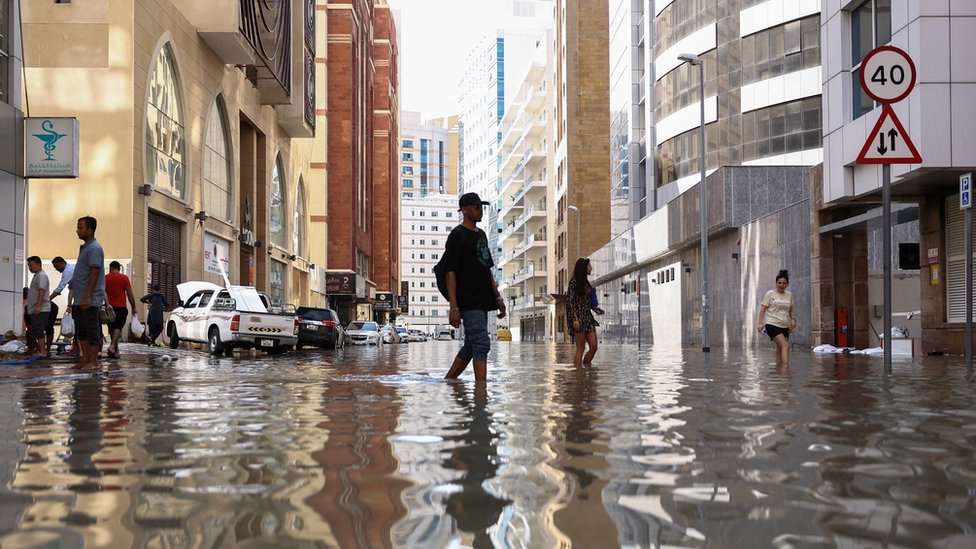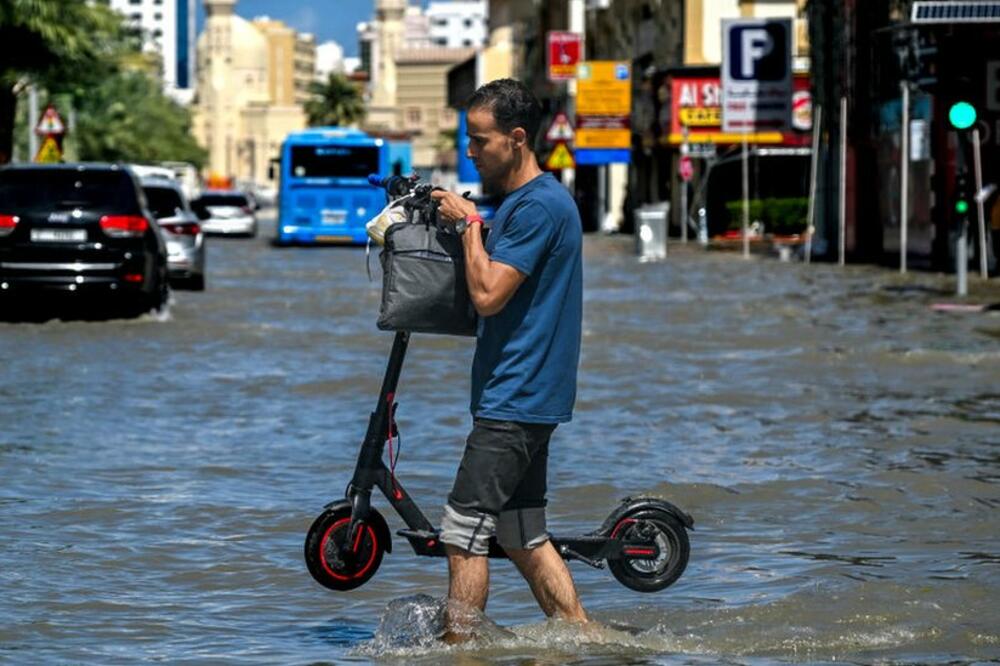Dubai has been hit by record floods in the last 24 hours, which has triggered misleading speculations about "cloud seeding".
So how unusual was this rainfall and what are the reasons for the extreme downpours?
How extreme was the rainfall?
Dubai is located on the coast of the United Arab Emirates (UAE) and is usually very dry.
But, although it receives an average of less than 100 millimeters of rain per year, it occasionally experiences extreme downpours.
- Where does the sand from the Sahara come from in raindrops in Serbia
- Flooding in Russia: "Colossal" amount of water is heading towards the city of Kurgan
- How to restore life and dry the house after a flood, the fourth time in seven years
- Once upon a time there was a city in Libya... it was called Derna
In the city of Al Ain - a little over 100 kilometers from Dubai - 24 millimeters of rain was recorded in just 256 hours.
The main reason was a "cut off" low pressure weather system, which pulled in warm, moist air and prevented other weather systems from breaking through.
"This part of the world is characterized by long periods without rain followed by irregular, heavy showers, but even with that in mind, this was a very rare rain event," explains Professor Marten Ambaum, a meteorologist at the University of Reading who studies rain patterns in the Gulf. areas.
Watch the video from Dubai:
What role has climate change played?
It is not yet possible to determine how much of a role climate change has played.
This would require a complete scientific analysis of natural and human factors, which could take up to several months.
But the record rainfall is consistent with the way the climate is changing.
Simply put: warmer air can hold more moisture - about seven percent more for every degree Celsius - which in turn can increase the intensity of rain.
"The intensity of the rain was a record, but this is consistent with a warming climate, with more available moisture driving storms and creating heavy downpours and consequent flooding that are progressively more severe," explains Richard Allan, professor of climate science at the University of Reading.
A recent study found that by the end of the century, annual rainfall could increase by up to 30 percent across much of the United Arab Emirates as the world continues to warm.
"If people continue to burn oil, gas and coal, the climate will continue to warm, rainfall will continue to be heavier, and people will continue to lose their lives in floods," said Dr Friederike Otto, senior lecturer in climate science at Imperial College. in London.

What is cloud seeding and did it play a role?
Cloud seeding involves manipulating existing clouds to produce more rain.
This can be done with the help of an airplane from which small particles (such as silver iodide) are thrown into the clouds.
Water vapor can then more easily condense and turn into rain.
This technique has been around for decades, and the United Arab Emirates has used it in recent years to solve its water shortage problem.
In the first hours after the floods, some social media users were quick to mistakenly attribute the extreme weather conditions solely to the country's recent cloud seeding operations.
Earlier reports from Bloomberg suggested that cloud-seeding planes were used on Sunday and Monday, but not on Tuesday, when the flooding occurred.
Although the BBC could not independently confirm when cloud seeding was carried out, experts say it would have had very little impact on the storm at best and that focusing on cloud seeding was "misleading".
"Even if cloud seeding encouraged the clouds around Dubai to release water, the atmosphere would most likely already have to contain more water for cloud formation to begin with, due to climate change," says Dr. Otto.
Cloud seeding is usually used when wind, moisture and dust conditions are insufficient to produce rain.
- All the lies of climate change deniers
- The story of "chemtrails" is spreading on the Internet - what is the truth in the conspiracy theory about aircraft trails
- False claims that US research station HAARP caused earthquakes in Turkey and Syria have gone viral
- Laser beams and other Hawaii fire conspiracy theories
Last week, meteorologists warned of a high risk of flooding across the Gulf.
"When such intense and massive systems are predicted, cloud seeding - which is an expensive process - is not done because there is no need to seed such strong regional-scale systems," says Professor Diana Francis, Head of Environmental and Geophysical Sciences at Khalifa University in Abu. Dabia.
BBC Weather meteorologist Matt Taylor also pointed out that extreme weather conditions had already been predicted in advance.
"Ahead of such an event, computer models (which do not account for the potential effects of cloud seeding) were already predicting that in about 24 hours, far more than the annual average would fall," he said.
"The effects were also much wider than I would have expected from mere cloud seeding - severe flooding affected large areas, from Bahrain to Oman."
Cloud seeding missions in the Emirate are led by the National Center for Meteorology, a government task force.
Watch the video from the Balkans: April snow after summer temperatures
How prepared is the United Arab Emirates for extreme rainfall?
Preventing heavy downpours from turning into deadly floods requires bulky defenses to deal with intense rainfall.
Dubai is, of course, extremely urbanized.
There are very few green areas that can absorb moisture, and drainage systems have not been able to cope with such a high level of rainfall.
"There must be adaptation strategies and measures to adapt to this new reality of more frequent and more intense rainfall," explains Professor Francis.
"For example, road infrastructure and facilities need to be adapted, building reservoirs to store water from spring rains and use it later in the year."
In January, the Roads and Transport Authority of the United Arab Emirates formed a new unit to help fight floods in Dubai.
Also watch this video:
Follow us on Facebook, Twitter, Instagram, YouTube i Viber. If you have a topic proposal for us, contact us at bbcnasrpskom@bbc.co.uk
Bonus video:




